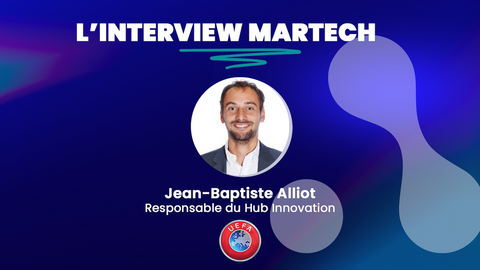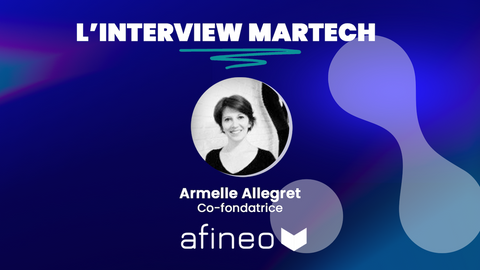Interview with Jean-Baptiste Alliot, Head of UEFA Innovation Hub
Since 2016, UEFA – the association representing national football federations across Europe – has embarked on a transformation and innovation journey with the goal of maintaining its position as the leading sport and entertainment entity. We interviewed Jean-Baptiste Alliot, the initiator and head of UEFA’s Innovation Hub, who discusses Data, Innovation, and Strategy.
UEFA's mission is to promote European football, its practice, and the organization of competitions (with the Euro and the Champions League being the most renowned). More information is provided at the end of this article.
Hello Jean-Baptiste, could you tell us about your background at UEFA?
I started in 2014 as a Project Manager for Education & Research. My role was twofold: developing leadership training programs and building partnerships with universities and research programs to enhance strategic decision-making in football. In 2017, I was responsible for International Relations with other confederations. Since 2018, I have been the initiator and director of the UEFA Innovation Hub.
In what context does UEFA operate today?
We operate in a rapidly changing landscape. Football, the number one sport in France and many neighboring countries, has been established for 30, 40, or even 50 years. However, in recent years, we have faced new forms of indirect competition regarding consumption and even the practice of the sport itself, with the rise of e-sports and cross-fit, among others. These are more accessible activities that allow for individual practice, with more gyms, flexible hours, and so on.
This notion of accessibility is also present among professionals, with audiences fragmented across various pay TV channels. Recently, new consumption modes like "snacking" (short content consumed quickly) have emerged. High-level football is now viewed as entertainment and competes with platforms like Netflix or TikTok. Therefore, our organization had to redefine itself to remain the leading sport and entertainment option in terms of interest, practice, and viewing.
Additionally, with the COVID-19 situation, we are seeing modifications in the European football landscape, particularly regarding “governance & ownership,” which we will closely monitor within the broader context of the attention economy.

How did your organization initiate this transformation?
Starting in 2016, leadership changes marked the beginning of this new era, with the aim of envisioning the future of football and maintaining our position as the top leisure activity. In 2017, the UEFA Intelligence Centre was launched to help leaders make the most informed strategic decisions based on trend studies and data. The Intelligence Centre focuses on three verticals: data, strategy, and innovation. We like to say that data informs strategy and innovation.
How did you contribute to this transformation? What were your initiatives?
Our top management is very attuned to this strategic shift and paradigm change. My Director also saw the value in it. We were all convinced that UEFA needed to transform and integrate our data into strategic thinking. In 2018, under our initiative, the UEFA Innovation Hub was launched. The Innovation Hub is attached to the Financial Sustainability & Research division, which handles Club Licensing and Financial Fair Play issues. It is important to note that UEFA is a non-profit organization that redistributes almost all of its revenue to national federations and clubs. To participate in our competitions and receive grants, federations must be transparent and commit to investing a certain percentage of their budgets in infrastructure, women's sections, and youth programs. Clubs, in particular, must adhere to the principle of financial fair play by not spending more than they earn. While it might seem surprising, positioning the Innovation Hub within this division provides us with a detailed understanding of our environment and a valuable source of information and data.
How does UEFA reinvent itself through initiatives like the Innovation Hub to remain a leader in Sport Entertainment?
What are the missions and objectives of the Innovation Hub?
We envisioned the Innovation Hub around three main pillars: Cultivate, Connect, and Curate!
-
Cultivate aims to create an internal culture of innovation. Historically, we haven’t had a culture of “business transformation.” We are not a company with an engineering culture like aerospace or automotive industries, with an understanding of innovation cycles, nor are we data experts. We have created a Lab to incubate new ideas, accelerate projects, and provide tools to be more flexible and capable of meeting today’s and tomorrow’s challenges.
-
Connect focuses on integrating innovative startups and other external partners (SMEs, research centers, etc.) into defined projects. Given that we do not have the resources to drive disruptive innovation ourselves, we adopt an incremental strategy with numerous partners. Sourcing these innovative companies is therefore a significant challenge for us, and we organize Challenges where they can apply and present their projects, as well as an Open Innovation scheme.
-
Curate concerns medium and long-term strategic research. A dedicated team works on anticipating future needs based on new technologies and the evolving business model of sport. Our goal is also to think about 2025 or even 2030, exploring new development avenues with an ecosystemic approach. For instance, trends in wellness, data, and new consumption habits. Will we still consume football for 90 minutes in the future? What could our value proposition be for certain segments (current or new)? And who are the relevant stakeholders to maintain this value proposition?

What is your relationship with broadcasters? Are they involved in innovation challenges?
A broadcaster has exclusivity over match footage during the game and for a certain period. However, we remain particularly attentive to extending the experience and providing fans with more exclusive and immersive content. In our new approach to promoting football differently, we work in co-strategy with broadcasters on innovative technologies. For example, we have engaged with WSC Sport, which automatically generates real-time highlight videos. This tool allows us, at the end of the match, to provide a broadcaster or any other UEFA partner with videos of specific events from the match according to their preferences and without human intervention (AI only).
And what about your relationships with brand partners?
For partners and sponsors, the approach is similar; we assist them by providing content they can quickly utilize and distribute through their channels. We can mention Greenfly or Slate as examples. We are also exploring technologies that help identify view angles without competing logos or with specific brand logos. Additionally, tools that allow content to be overlaid, logos added, or adapted based on context or emotion are of interest. For instance, why not imagine content adapting based on the perceived emotion of the viewer(s)? This is becoming increasingly common in films. Depending on the situation and emotions, content can be configured or added accordingly. Although this is not necessarily a current focus, we keep a necessary watch on these themes. Furthermore, our innovation efforts are not limited to this; we are attentive to advanced player data tracking, envisioning new, more immersive experiences, such as augmented reality. We are also working closely on the “purpose” theme in collaboration with our partners.
Within the Innovation Hub, what types of data can you collect?
We manage two main types of data: those related to the football ecosystem (federations, clubs, etc., primarily financial data, as previously mentioned) and those related to our fans, such as app users, spectators, viewers, and football enthusiasts more broadly. For example, when we sell tickets for the Euro, we have a huge number of spontaneous registrations on the UEFA site compared to the number of available tickets. However, this is relatively episodic due to our competitions. To regularly feed our database, we work on various acquisition operations with partners like EA Sport (publisher of the FIFA video game) for our club competitions. Additionally, we recently partnered with Disney to encourage the involvement of young and female audiences in football.
What is the data strategy that the Innovation Hub is trying to implement?
One of our goals is to explore technologies that UEFA can implement to improve data, making it more accessible and usable. From a marketing perspective, our strategy is to expand our database and attract future consumers like any brand. As in many organizations, we sometimes still operate in silos. For example, we developed an internal ticketing app using blockchain technology. However, it was not connected to our CRM, and we will be working on this soon because it is challenging for us to understand the fan’s user journey without differentiating between pre/during/post-match moments and ticket purchase and usage.
Our strategy is to harmonize data and tools in four stages: Infrastructure, Processing, Analysis, and Insights. How and where should this data be stored? Then, how can our database be automatically fed, and at what frequency? Finally, how do we "clean" this data to analyze, measure, and draw insights to influence our strategies?

How was the creation of the Innovation Hub perceived internally? How did you generate interest?
The creation of the Innovation Hub was received very positively internally, primarily due to our pragmatic and results-oriented approach. Instead of aiming for spectacular projects without lasting impact, we focused on concrete and immediately useful initiatives. We launched projects such as the UEFA Player Card, the Futsal App in collaboration with the French startup My Coach, and enhanced engagement on UEFA.tv with Livelike widgets. These initiatives were designed to deliver tangible results quickly, which allowed us to convincingly demonstrate our value.
Through these “quick wins,” we were able to show real and concrete results, generating growing interest within UEFA.
Today, we receive direct requests from our colleagues and stakeholders, indicating that our initial approach successfully attracted and maintained interest without the need for as much outreach as at the project’s launch. In less than two years, we have implemented around ten projects with startups, all of which are ongoing with tangible results, reflecting our initial success.
What are your long-term projects?
For our long-term projects, we focus on ambitious initiatives aimed at having a significant and lasting impact. Here are a few examples:
-
Immersive Projects with Oculus: We are exploring opportunities to develop immersive virtual reality experiences that could transform fan engagement and the way football is consumed.
-
Football Innovation Cluster: We have created an innovation cluster in football that brings together federations, clubs, stadiums, media, and brands. This network allows us to conduct large-scale tests and develop strategies based on the latest emerging trends and technologies. This cluster is crucial for testing new ideas and adjusting our strategy according to market developments.
-
“Curate” Axis: We are working on formulating strategies based on trends and technologies that we analyze and observe emerging today. This involves continuous monitoring and in-depth analysis of developments in the sports and related technology sectors.
Can you present some of the projects the Innovation Hub is working on?
-
Collaboration with Greenfly: We are developing a strategy to enhance the creation and distribution of digital content during our competitions, such as EURO 2020. This involves working with our member associations as well as with athletes and influencers to maximize content impact. We are also collaborating with Slate to provide near-instantaneous graphical overlays for this content, which is particularly attractive to sponsors.
-
UEFA Playmaker Campaign with Disney: In partnership with Disney, we launched the UEFA Playmaker campaign to encourage young girls to play football. We utilized the imagery from the film The Incredibles to inspire and build confidence in young athletes. This initiative aims to promote women's football and encourage young people to engage in the sport.

Our goal remains to ensure that by 2030, as many women as possible are playing football, and that they pass on this passion to their children when they become mothers.
- We have a project with Google to create 3D models of major stadiums, which will help reduce travel and, consequently, our carbon footprint.
- We are also in discussions with GreenPark, which is redefining how fans interact with and experience football. They are developing a gaming platform that transforms fans from mere spectators into active participants. This platform will cater to all types of fans, from the most dedicated to the least engaged.

To conclude, what motivates you on a daily basis?
The common perception is that football is top-tier entertainment and that this is normal. However, this is not normal; it does not happen by chance. Will football continue to be consumed and practiced as much in the future? For 90 minutes? The leading market for sports entertainment is the US, where football is far from being the most-watched sport. Our strategies aim to ensure that football remains the primary source of entertainment and participation. This is what motivates us because every day we must challenge ourselves, discover new things, and learn from both internal and external collaborators while working for an organization and a sport that has a genuinely positive impact on society with its admirable missions and values.

About UEFA :
The Union of European Football Associations (UEFA) is an organization that unites and represents the national football associations across Europe.
- Founded in 1954,
- Headquartered in Switzerland (Nyon),
- With 55 member nations,
- UEFA develops, protects, and promotes football at the European level, and oversees both men's and women's competitions, including the European Championship and the Nations League (national competitions), as well as the Champions League, Europa League, and UEFA Super Cup (club competitions).
- It is also responsible for women's football competitions.
- UEFA is a non-profit organization that redistributes over 80% of its revenue to national associations and clubs.
Interested in learning more about our innovation and hub support?
Other interview with marketing and digital professionals you might like :
Thierry Moussu, Digital Relations Manager at Total Direct Energie





